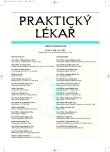Epileptic fit as a syncope equivalent in severe aortic stenosis.
Epileptické paroxysmy jako ekvivalent synkopy u těžké aortální stenózy
V kazuistice předkládáme případ pacienta akutně přijatého na koronární jednotku pro dušnost a tlakové oprese na hrudi. Podle anamnézy udával opakované křečové stavy v posledních měsících, které byly dokumentovány i během hospitalizace na monitorovaném lůžku.
Transtorakální echokardiografické vyšetření (TTE) prokázalo středně těžkou dysfunkci levé komory (LK) s ejekční frakcí (EF) 33 % a těsnou aortální stenózu. Na elektroencefalografu (EEG) byly zachyceny epileptické paroxysmy a transkraniální ultrazvukový scan (TCD) dokumentoval snížené rychlosti průtoku ve Willisově okruhu. Po kardiochirurgickém výkonu, při němž byla aortální chlopeň nahrazena mechanickou protézou SJM Regent 25 mm, došlo postupně ke zlepšení kinetiky i celkové funkce LK. Normalizoval se EEG nález a pacient je klinicky nadále bez epileptických záchvatů. Případ aortální stenózy vyvolávající epileptické záchvaty během přechodné mozkové hypoperfúze (vedoucí k hypoxii) považujeme za ojedinělý a z téhož důvodu poučný.
Klíčová slova:
těsná aortální stenóza, sekundární epilepsie.
Authors:
A. Krüger; P. Niederle
Authors‘ workplace:
Nemocnice Na Homolce, Praha
; Přednosta: prof. MUDr. Petr Niederle, DrSc.
; Kardiologické oddělení
Published in:
Prakt. Lék. 2007; 87(4): 241-242
Category:
Case Report
Overview
The case report of a patient suffering from dyspnea and chest pain together with a history of repetitive epileptic paroxysms within the past few months is presented. The epileptic fits were also registered during his hospital stay. Transthoracic echocardiography proved moderate left ventricular dysfunction (ejection fraction 33 %) and severe aortic valve stenosis (peak pressure gradient 102 mmHg, aortic valve area 0.45 cm2). The epileptic fits were also documented by electroencephalography (EEG) and a transcranial Doppler study detected reduced blood flow within the intracerebral arteries. The patient underwent successful cardiosurgery to replace the stenotic aortic valve with a mechanical prothesis (SJM Regent 25 mm). Myocardial function showed marked improvement (EF 50 %) following the procedure. Repeated EEG examination exhibited completely normal findings. At present, the patient remains in good health without any epileptic fits. We consider the case of aortic stenosis inducing epileptic symptoms caused by transient cerebral ischemiaextremely rare and informative for general practitioners and other physicians.
Key words:
severe aortic stenosis, secondary epilepsy.
Labels
General practitioner for children and adolescents General practitioner for adultsArticle was published in
General Practitioner

2007 Issue 4
- Metamizole at a Glance and in Practice – Effective Non-Opioid Analgesic for All Ages
- Memantine in Dementia Therapy – Current Findings and Possible Future Applications
- Advances in the Treatment of Myasthenia Gravis on the Horizon
- Hope Awakens with Early Diagnosis of Parkinson's Disease Based on Skin Odor
- Metamizole in perioperative treatment in children under 14 years – results of a questionnaire survey from practice
Most read in this issue
- Todays trends of diagnostics and treatment of scaphoid bone fractures
- Extensive trombosis of thoracic aorta – an unusual source of acute peripheral arterial embolism.
- Epileptic fit as a syncope equivalent in severe aortic stenosis.
- Smoking and skin
